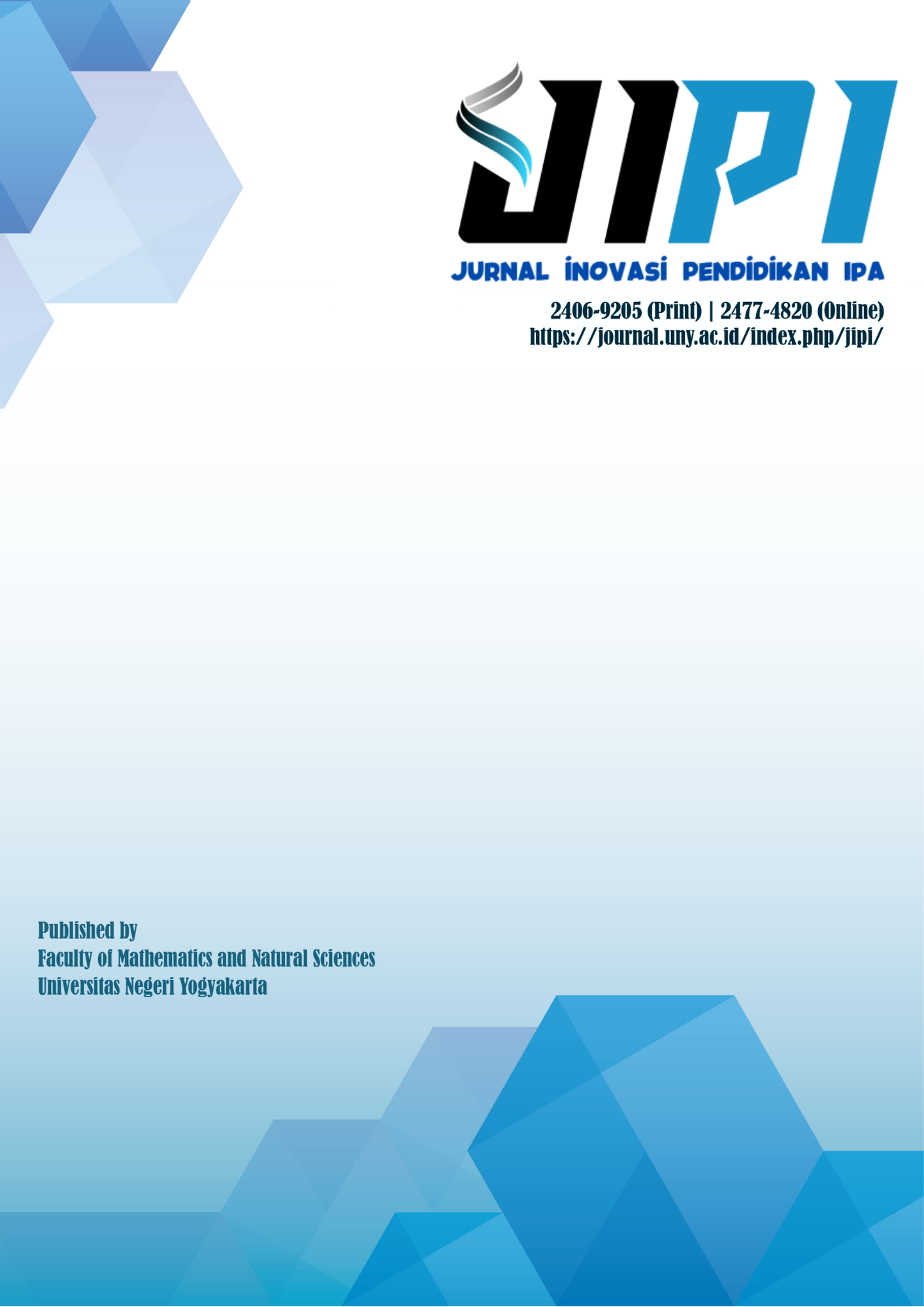The Effectiveness of The POE2WE Learning Model in Supporting Distance Learning in The Era of The Industrial Revolution 4.0
DOI:
https://doi.org/10.21831/jipi.v8i1.55767Keywords:
Distance Learning, Industrial Revolution 4.0, POE2WEAbstract
References
Akhmalia, NL, Maharta, N., & Suana, W. (2018). The Effectiveness of LMS-Based Blended Learning with Inquiry Learning Models on Static Fluid material on Students' Mastery of Concepts. Journal of Physics Education Innovation and Scientific Research , 56-64.
Arikunto, S. (2010). Fundamentals of Educational Evaluation. Jakarta: PT. Script Earth
Bao, W. (2020). COVID -19 and online teaching in higher education: A case study of Peking University. Pedagodical Research, 5(4).
Calimag, JN, Mugel, PA, Conde, RS, & Aquino, LB (2014). Ubquitous Learning Environment Using Android Mobile Application. International Journal of Research in Engineering & Technology . 2(2): 119-128.
Crawford, J., Butler-Henderson, K., Rudolph, J., Glowatz, M., Burton, R., Paola, M., & Lam, S. (2020). COVID-19: 20 Countries' Higher Education Intra-Period Digital Pedagogy Responses . Journal of Applied Learning & Teaching . 3(1): 1 – 20.
Costa, G. J. M. D., Silva, N., & Fonseca, T. (2012). Moral reasoning in knowledge authoring: An e-learning 4.0 analysis!. Computers in Education, 135-154.
DeVore, S. & Sing, C. (2020). Interactive Learning Tutorial on Quantum Key Distribution. Physical Review Physics Education Research 16 , 010126.
Dwi Sulisworo, M. T. (2021). Dampak Covid-19 Terhadap Kebijakan Pendidikan di Indonesia: antara Idealisme dan Realitas. UAD PRESS.
Formanek, M., Buxner, S., Impey, C., & Wenger, M. (2019). Relationship between Learners' Motivation and Course Engagement in an Astronomy Massive Open Online Course. Physical Review Physics Education Research 15, 020140.
Jumini, S. (2016). Inquiry-based problem-based learning in terms of scientific attitude and student creativity. Spektra: Journal of Science Education Studies, 2(1), 10-19.
International Labor Organization. (2020). Impact of Lockdown Measures On The Informal Economy. ILO briefs.
Kuo, YC, Walker, AE, Schroder, KEE, & Belland, BR. (2014). Interaction, Internet self-efficacy, and self-regulated learning as predictors of student satisfaction in online education courses. Internet and Higher Education. https://doi.org/10.1016/jiheduc.2013.10.001
Indonesian Media. (2020, June 16). The Impact of the Pandemic, the Quality of Education Has Declined . Retrieved from mediaindonesia.com: https://mediaindonesia.com/humaniora/321039/dampak-pandemi-quality-education-alami-penurunan.
Indrayana, B., & Sadikin, A. (2020). Penerapan E-Learning Di Era Revolusi Industri 4.0 Untuk Menekan Penyebaran COVID-19 : (The Application of E-Learning in the Era of the Industrial Revolution 4.0 to Suppress the Spread of COVID-19). Indonesian Journal of Sport Science and Coaching, 2(1), 46-55.
Mason, R., & Rennie, F. (2006). Elearning: The key concepts. Routledge.
Moore, JL, Dickson-Deane, C., & Galyen, K. (2011). E-learning, online learning, and distance learning environments: Are they the same? Internet and Higher Education. https://doi.org/10.1016/jiheduc.2010.10.001
Nana. (2020). The Effectiveness of the POE2WE Model in Delivering Scientific Method Materials to Improve Student Learning Outcomes and Interests
Nana. (2018). Model Prediction, Observation, Explanation, Elaboration, Write and Evaluation (POE2WE) Alternative Physics Learning in the Era of the Industrial Revolution 4.0
Nichols, M. (2003). A theory for eLearning. Journal of Educational Technology & Society, 6(2), 1-10.
Nuryatin, S. (2020). Adaptasi metode pembelajaran melalui e-learning untuk menghadapi era new normal.
Oknish, N., & Suyoto, S. 92019). Using APLEN (Online Application) as an Effort for Student Learning Independence. In Basic Education National Seminar (Vol. 1, No. 01)
Reimers, FM, Schleicher A., & Ansah GA (2020). Schooling Disrupted, Schooling Rethought: How the Covid-19 Pandemic is Changing Education. OECD. Oye, ND, Salleh, M., & Iahad, NA (2012). E-Learning Methodologies and Tools. International Journal of Advanced Computer Science and Applications. 3(2): 48-52.
Permata, Andira; Bhakti, Yoga Budi. (2020). The Effectiveness of Virtual Class with Google Classroom in Physics Learning During the Covid-19 Pandemic. Journal of Physics Education Innovation and Scientific Research, 27-33.
Putra, IA & Sujarwanto, E. (2017). Analysis of Students' Science Process Skills through Interactive Multimedia Teaching Materials Measuring and Measurement Tools with a Behavioristic Approach. Momentum: Physics Education Journal. 1(2): 91-102.
Procedia - Social and Behavioral Sciences 176: 129 – 138. Wilcox, BR & Pollock, SJ (2019). Investigating Students' Behavior and Performance in Online Conceptual Assessment. Physical Review Physics Education Research 15, 020145.
Sabaruddin, Marzuki, & Khairunnisak. (2020). Pandemic Covid-19: The Opportunities and Challenges to Using ICT in Mathematics Learning. IJEBD International Journal of Entrepreneurship and Business Development EISSN 2597-4785 PISSN 2597-4750, 3 (4), 409-414.
Sahara, Rasid Abdul, dkk. (2022). Proyek Video dalam Pembelajaran Jarak Jauh Selama Masa Pandemi Covid-19: Kesiapan, Proses, dan Manfaat. Jurnal Inovasi Pendidikan IPA (Vol. 8, No. 2)
Shahabadi, MM & Uplane, M. (2014). Synchronous and Asynchronous-Learning Styles and Academic Performance of E-Learners
Sobron, AN, & Bayu, R. (2019). Student Perceptions in the Study of the Effect of Online Learning on Interest in Learning Science. Scaffolding: Journal of Islamic Education and Multiculturalism, 1(12), 30-38.
Downloads
Published
How to Cite
Issue
Section
Citation Check
License
The authors submitting a manuscript to this journal agree that, if accepted for publication, copyright publishing of the submission shall be assigned to Jurnal Inovasi Pendidikan IPA (JIPI). However, even though the journal asks for a copyright transfer, the authors retain (or are granted back) significant scholarly rights.
Jurnal Inovasi Pendidikan IPA by http://journal.uny.ac.id/index.php/jipi/index is licensed under a Creative Commons Attribution-ShareAlike 4.0 International License.










